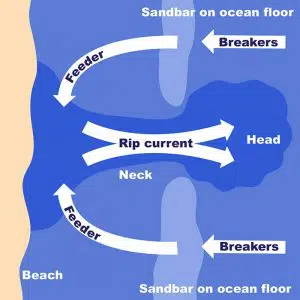Have you spent any time at the beach this summer?
As a snowbird, I’m fortunate to live near the water at my home in Michigan as well as my home in Florida. Being near water is great not only for kicking back and sipping a glass of wine as the sun slips away into the evening; I also find it an effective place to work. Of course, as a mystery writer I am well aware that beauty is often coupled with great danger – this is especially true of large bodies of water!
As I do with each of my books, while I was writing Jack of Spades I did a ton of research and one of the subjects I found deadly interesting was rip currents.
A rip current is a long narrow channel of water that moves away from the shore at high speed. At their most dangerous, rip currents can move as fast as 8 feet per second. These currents can seemingly appear out of nowhere, taking even the strongest swimmers off guard and pulling them out into deep water.
Rip currents are responsible for over 100 drownings in the US alone each year. Fortunately, many of these deaths can be prevented through education.
So here’s what you need to know.
Rip currents can develop in any body of water where there are breaking waves and for the average swimmer, they can be difficult to spot. Although they are more likely to occur during bad weather like thunderstorms, they can occur at any time and are especially common between August and October. It’s important to note that rip currents are not the same as rip tides, which are caused by the fast-moving tidal water rather than waves.
If you find yourself caught in a rip current it is essential that you do not panic. Rip currents are not likely to pull you under nor to carry you out to sea. They usually don’t extend beyond 50-100 feet from the shoreline.
Image courtesy of Scijinks.gov
Most people drown in rip currents because they expend all of their energy frantically fighting the current. That is why it is important not to attempt to swim against the current directly back to shore. Instead, you should try to stay afloat and, if you’re a strong swimmer, swim parallel to the shoreline out of the current as most rip currents are only 20-100 feet wide. If you aren’t a strong swimmer, flip onto your back into a floating position and allow the tide to pull you out until it has dissipated. Most rip currents will deposit you back on the shore. If you are at a busy beach, call “Help!” as loudly as you can, rather than screaming which may blend in with the noise.
Although being caught in a rip current is a terrifying experience, for some it is a thrill. Many experienced surfers use rip currents to help them paddle out to sea.







Comments are closed.